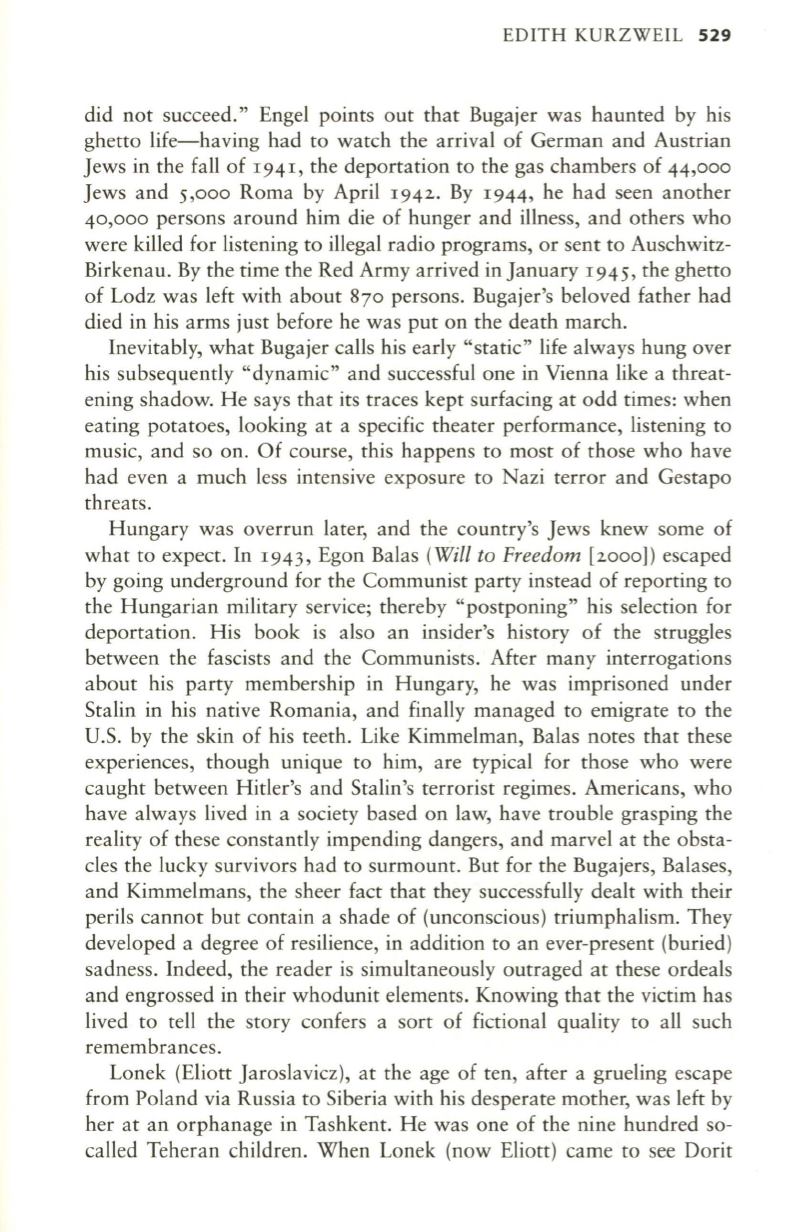
EDITH KURZWEIL
529
did not succeed." Engel points out that Bugajer was haunted by his
ghetto life-having had to watch the arrival of German and Austrian
Jews in the fall of
1941,
the deportation to the gas chambers of
44,000
Jews and
5,000
Roma by Apri l
1942.
By
1944,
he had seen another
40,000
persons around him die of hunger and illness, and others who
were killed for listening to illegal radio programs, or sent to Auschwitz–
Birkenau. By the time the Red Army arrived in January
1945,
the ghetto
of Lodz was left with about
870
persons. Bugajer's beloved father had
died in his arms just before he was put on the death march.
Inevitably, what Bugajer calls his early "static" life always hung over
his subsequently "dynamic" and successful one in Vienna like a threat–
ening shadow. He says that its traces kept surfacing at odd times: when
eating potatoes, looking at a specific theater performance, listening to
music, and so on. Of course, this happens to most of those who have
had even a much less intensive exposure to Nazi terror and Gestapo
threats.
Hungary was overrun later, and the country's Jews knew some of
what to expect. In
1943,
Egon Balas
(Will to Freedom
[2000])
escaped
by going underground for the Communist party instead of reporting to
the Hungarian military service; thereby "postponing" his selection for
deportation. His book is also an insider's history of the struggles
between the fascists and the Communists. After many interrogations
about his party membership in Hungary, he was imprisoned under
Stalin in his native Romania, and finally managed to emigrate to the
U.S. by the skin of his teeth. Like Kimmelman, Balas notes that these
experiences, though unique to him, are typical for those who were
caught between Hitler's and Stalin's terrorist regimes. Americans, who
have always lived in a society based on law, have trouble grasping the
reality of these constantly impending dangers, and marvel at the obsta–
cles the lucky survivors had to surmount. But for the Bugajers, Balases,
and Kimmelmans, the sheer fact that they successfully dealt with their
perils cannot but contain a shade of (unconscious) triumphalism. They
developed a degree of resilience, in addition to an ever-present (buried)
sadness. Indeed, the reader is simultaneously outraged at these ordeals
and engrossed in their whodunit elements. Knowing that the victim has
lived to tell the story confers a sort of fictional quality to all such
remembrances.
Lonek (Eliott Jaroslavicz), at the age of ten, after a grueling escape
from Poland via Russia to Siberia with his desperate mother, was left by
her at an orphanage in Tashkent. He was one of the nine hundred so–
called Teheran children. When Lonek (now Eliott) came to see Dorit


